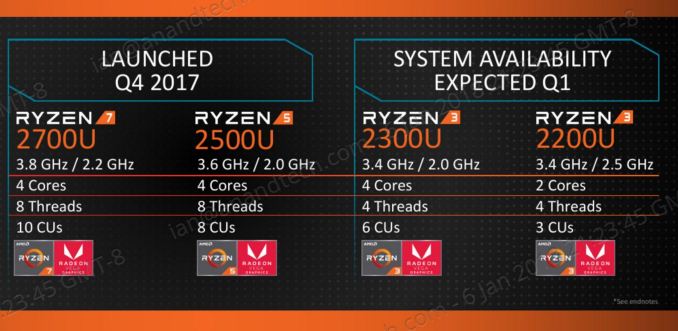AMD Tech Day at CES: 2018 Roadmap Revealed, with Ryzen APUs, Zen+ on 12nm, Vega on 7nm
by Ian Cutress on February 1, 2018 8:45 AM ESTZen Cores and Vega
Ryzen 3 Mobile, Plus More Ryzen Mobile Laptops
The most immediate announcement from AMD is two Ryzen 3 Mobile processors designed to fill out the Mobile stack, and the introduction of Ryzen-based APUs for desktop machines.
At the heart of both of these designs is the combination of AMD’s first-generation Zen cores, specifically four cores in a ‘core complex’, connected to Vega-based graphics integrated into the silicon. The two units are connected via AMD’s Infinity Fabric, designed for high-bandwidth and scale, and a feature that permeates through AMD’s recent product portfolio.
Ryzen Mobile
To date, AMD has already announced two products using this configuration. Both of them are for Ryzen Mobile, specifically the Ryzen 7 2700U and Ryzen 5 2500U, which have already been pre-announced in devices such as the HP Envy x2, the Lenovo Ideapad 720S, and the Acer Swift 3. Only the HP Envy x2 has been launched into the market so far (with mixed reviews due to the OEM design, which draws similar criticisms when equipped with Intel CPUs), with the others to see light in Q1 as well as other OEMs like Dell.
The first announcement is regarding adding more Ryzen Mobile processors to the family to cater for a wider audience. To pair with the Ryzen 7 Mobile and Ryzen 5 Mobile, AMD has two Ryzen 3 Mobile parts which will formally be available on January 9th with expected system availability within Q1.
| AMD Ryzen Mobile APUs | |||||
| Ryzen 7 2700U with Vega 10 |
Ryzen 5 2500U with Vega 8 |
Ryzen 3 2300U with Vega 6 |
Ryzen 3 2200U with Vega 3 |
FX-9800P (2015) |
|
| CPU | 4C / 8T 2.2 GHz Base 3.8 GHz Turbo Zen 14nm |
4C / 8T 2.0 GHz Base 3.8 GHz Turbo Zen 14nm |
4C / 4T 2.0 GHz Base 3.4 GHz Turbo Zen 14nm |
2C / 4T 2.5 GHz Base 3.4 GHz Turbo Zen 14nm |
Dual Module 2.7 GHz Base 3.6 GHz Turbo Excavator 28nm |
| GPU | Vega 10 10 CUs 640 SPs < 1300 MHz |
Vega 8 8 CUs 512 SPs < 1100 MHz |
Vega 6 6 CUs 384 SPs |
Vega 3 3 CUs 192 SPs |
GCN 1.2 8 CUs 512 SPs > 758 MHz |
| TDP | 15W | 15W | 15 W | 15 W | 15W |
| DRAM | Up to DDR4-2400 | DDR4-1866 | |||
| L2 Cache | 512 KB/core | 1 MB/module | |||
| L3 Cache | 1 MB/core | 4 MB/core | - | ||
| PCIe Lanes | ? | ? | ? | ? | 8 x PCIe 3.0 |
| Die Size | 209.78 mm2 | 250.4 mm2 | |||
| Transistors | 4.95 billion | 3.1 billion | |||
| Launch | October 2017 | January 2018 | May 2016 | ||
The Ryzen 3 2300U is a quad-core processor without simultaneous multithreading, which separates it from the other components. The base frequency of 2.0 GHz, a top turbo of 3.4 GHz, and a total of six compute units in the Vega graphics (this equates to 384 streaming processors). The Ryzen 3 2300U shares the same TDP as the other parts, coming in at 15W, and AMD wants to position this as a high-performance part for eSports capable notebooks, handily beating anything from Intel’s 7th Generation family.
The Ryzen 3 2200U is the only dual core component in AMD’s entire Ryzen product line, although it does have simultaneous multithreading to give it four threads in total. Having two fewer cores to fire up does give it a boost on the base frequency, coming in at 2.5 GHz, but the turbo frequency matches the other Ryzen 3 at 3.4 GHz. The 2200U is certainly the processor bringing up the rear, with only three compute units (192 streaming processors) in total, and helping AMD shift some of the processors that are not binned as aggressively as the higher-performance units.
AMD is promoting these two processors as capable elements of an entry level 15W notebook that can process DirectX 12, offer advanced video features, and be used in aesthetically pleasing designs with a long battery life, including 2-in-1s, ultrathin notebooks, and gaming laptops.
New Devices
Not to be content with just announcing a couple of new Ryzen Mobile processors, AMD was eager to promote new mobile devices that will be using Ryzen Mobile. To accompany the HP Envy x360, the Lenovo Ideapad 720S, and the Acer Swift 3, Q1 will see the launch of a new HP (under embargo until later this week), the Acer Nitro 5 series, and the Dell Inspiron 5000 series.
Acer’s Nitro line of laptops is typically aimed at the gaming crowd. The Nitro 5 dictates a 15.6-inch display, which in this case is a 1920x1080 IPS panel. Acer will use the pre-announced higher-end APUs, the Ryzen 7 2700U and Ryzen 5 2500U, but will also be pairing this with a Radeon RX 560 graphics chip. We were told by AMD that the integrated graphics and discrete graphics will be used in a switching context: for video playback, the lower power integrated graphics is used and the discrete is disabled, however the discrete graphics is fired up for gaming work. For compute, or for games that support multi-adaptor DirectX 12 technologies, both the integrated graphics and the discrete graphics should be available, however this is up to the game/software to implement.
The Dell Inspiron lines are more home/small-medium business-oriented devices, and here Dell is also using the Ryzen 7 2700U and Ryzen 5 2500U processors to offer peak Mobile APU performance. Designed more as a workhorse than for aesthetics, the Inspiron 5000 will offer AMD parts with 15.6-inch and 17-inch displays in a chassis that can support dual HDD/SSD options. The unit also comes with an optional Radeon 530 discrete GPU, which has 384 compute units based on AMD’s older GCN 1.0 architecture. This comes across as very odd, given that even the Ryzen 5 has 512 compute units of the newer Vega architecture. I can only assume that this provides extra displays for very specific customers, though for most it would seem an overly pointless addition.














131 Comments
View All Comments
Ian Cutress - Sunday, January 7, 2018 - link
Hey everyone, thanks for coming to read about AMD's roadmaps. I want to go into a lot more detail on what came out of AMD's Tech Day, particularly about APUs, 12nm, 7nm, Vega, new APU pricing, the X470 chipset and so on, but a pretty bad strain of CES flu is doing the rounds and this year I'm an unlucky recipient. It's not completely debilitating, but bad enough for me to lose concentration that I might have to cancel a few meetings at the show tomorrow as a result if I can't string a coherent thought together.Rather than post a garbled mess, I want to get around to detailing the news for you all properly, as there's a lot of nuances to go into. We also had an interview with Dr. Lisa Su about AMD in 2018. Stay tuned for updates over the next couple of weeks, as I stay hydrated and call room service for chicken soup!
Eris_Floralia - Monday, January 8, 2018 - link
Ian, isn't Ryzen 3 2200U utilizing a new dual core die?They did have a dual core die with 3 CUs on their former roadmap.
Ian Cutress - Monday, January 8, 2018 - link
AMD has one die design covering the whole of Ryzen Desktop + Threadripper + EPYC, and one die design covering Ryzen Mobile + Ryzen APUs. They're not going to spend a third amount of money on masks for a single low-end dual-core die with a few CUs unless it was going to expand into a new segment of products. Given that AMD has been quite open about its 2018 roadmap today, I doubt that would happen.Eris_Floralia - Monday, January 8, 2018 - link
Thanks Ian.I'm also quite surprised they didn't announce the new die on CES if it will be coming. So it's just harvested dies....
mczak - Monday, January 8, 2018 - link
Well there is a 2 core / 3 CUs design on the roadmap - Banded Kestrel. This is however intended for embedded. Although it is rather similar to the Bristol Ridge / Stoney Ridge split, and the latter also showed up in non-embedded markets.However, just like Stoney Ridge, Banded Kestrel will be limited to single-channel memory. I always assumed it's going to show up in cheap notebooks/PCs, basically as a Pentium Silver competitor, but of course I could be wrong (in any case, it's not ready yet).
StevoLincolnite - Monday, January 8, 2018 - link
Error on the second page in the table..."Vega 3
3 CPUs
192 SPs"
Should be:
"Vega 3
3 CUs
192 SPs"
Krysto - Monday, January 8, 2018 - link
Next time, supplement 10,000 IU Vitamin D3 a day, months before CES. You can thank me later.Dave Null - Monday, January 8, 2018 - link
This is actually very good advice.Most of us who sit in front of computers all day aren't getting enough vitamin D. Vitamin D plays a major regulatory role in our immune systems. Since realizing I was deficient in vitamin D a few years ago (your doctor can easily test for this), I've been supplementing it, and getting sick far less often as a result.
Rοb - Wednesday, January 24, 2018 - link
But I smoke heavily, drink coffee almost continuously, eat poorly and avoid the Sun, and don't take vitamin supplements.I haven't been sick in decades ...
Not that I would advise anyone to smoke nor offer medical advice but there's flu shots (which I also don't have) that will reduce your vulnerability rather than copy my lifestyle.
MFinn3333 - Thursday, February 1, 2018 - link
The problem with that attitude is that you are chipping away at your body's natural defenses against all kinds of diseases, such as COPD, over time.You are born with a lot of over-provision inside each of your organs. Those activities are eating away faster than normal. What happens when you run out of extra "space"? Same as on an SSD Degraded performance or size.